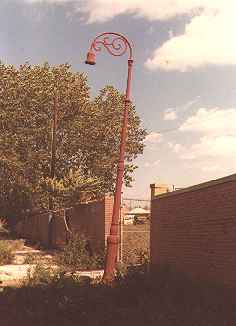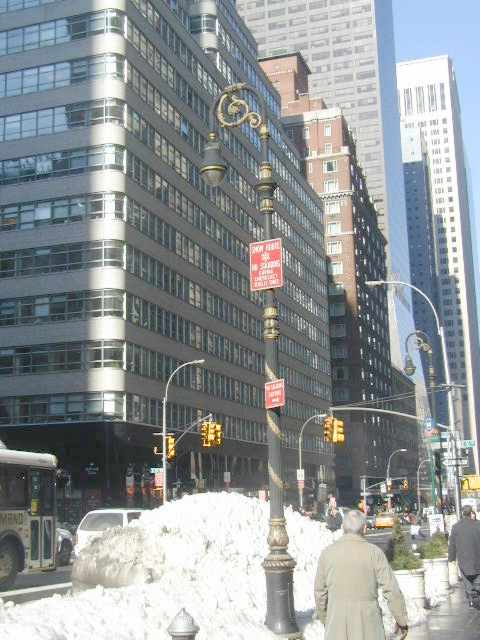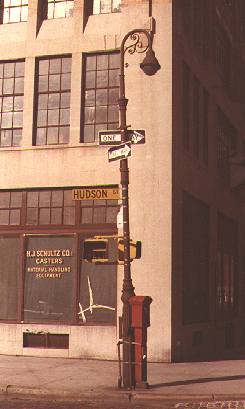
As many Bishops Crooks lampposts that are still standing…there are legions of these old warriors that are no more. As late as the early to mid 1980s, the streets of New York City were still greatly populated by these poles that imitated episcopal staffs. They kept a Little Old New York ambience wherever they stood.
In the mid-1980s, the Department of Transportation, in its mind-numbing attempts at conformity, either scrapped many of these relics or outfitted them with ultra-bright sodium vapor luminaires, considerably sapping their charm.
All this was in advance of the DOT’s new policy of installing brand new retro-crooks on streets like Sixth and Seventh Avenues. While these poles are an advancement over the uniform octagonal aluminum poles that preceded them, there’s a soullessness about them, since they’re all the same!
As you’ll see on this page, there was more than one brand of Crook, and each can be recognized for what it was…and each had its own particular personality.
All pictures on this page were snapped by Forgotten Fan Robert Mulero between about 1978 and 1985. Bob was a lamppost freak long before your webmaster thought to document them.
ABOVE: Walker and Centre, ca. 1980. Note that color coded street signs were still in vogue.
Anatomy of a Crook
All crooks weren’t born alike, and neither were cast-iron NYC streetlamps. NYC’s remaining castiron streetlamps first began appearing on NYC streets in 1892. Reportedly the designer of the lamppost was Richard Rogers Bowker, the founder of Publishers Weekly in 1872. The first one was built in conjunction with the 1892 Columbian Exposition, which commemorated the 400th anniversary of Columbus’ appearance in the New World. The first such lamps were installed on Fifth Avenue and were of the variety known colloquially as ‘twinlamps‘. A few lamps along Fifth Avenue today are of a somewhat later design that was based on that original design.
A few years later castiron lampposts of dozens of different designs appeared on main and side streets, and just as only a few species of reptiles remain from the vast number of them that walked the earth millions of years ago during the Age of Dinosaurs, just a few ‘species’ of castiron lamps have survived to the Information Age.
Like the remains of dinosaurs, the history of NYC castiron streetlamps is a sketchy and unclear one. The DOT has not kept a formal history. It’s likely that the best document we have available is a 1934 study called The System Electric Companies: Photographs of Street Lighting Equipment. It identifies fully 77 varieties of standard streetlamps in NYC as of 1934. There are only 19 of those designs that have representatives on the streets of NYC today!
Today, we’ll focus on the Bishops Crooks: those poles that have a curved top reminiscent of the staffs that bishops carry in their cermonial duties. The System Electric Companies identify five distinct types of Bishop Crook, and I’ve discovered even more variants. Enough yakkin’… let’s get to the Crooks!
TYPE 1BC
According to the System Electric Companies’ study (to save my fingers, I’ll call it the SEC here on out) the 1BC was the earliest type of Bishop Crook to appear.
The Type 1BC’s outstanding features are garland scrolling that winds all the way up the pole, as well as a “ladder rest” that is a carryover from the earler gaslight poles.
The Type 1BC boasts castiron on its entire shaft, unlike later models. The shaft is somewhat thinner, and the pole is rather shorter than some of the long-necked Bishops that appeared later.
The Bishop at left guarded Trinity Church at Broadway and Wall Street for decades until about 1990 when it succumbed. There are a couple of other 1BCs on lower Broadway that have been given new sodium vapor luminaires.
At right, a Type 1BC illuminates 10th Avenue beneath the IRT in the East 210s. Note the platform lamps: these designs, too, are fast disappearing.
City Hall Park was where many 1BC’s lived and worked, but the poles have been redesigned along with the rest of the park. Both East 48th and East 49th Street between Park and Lex boast 1BC’s, as well as the corner of Canal and Lafayette.
The Type 1BC that stood at Patchin Place and West 10th Street for many years was recently replaced by a newer Retro-Crook, but fear not…
…it found a place across the street in the Jefferson Market Library Courtyard.
TYPE 24A
Type 24A is the commonest Crook in New York City…before 1950, when they ruled the streets, and even now. I suppose you can call them the Archbishop Crooks. The new retro-crooks being cast today are replicas of this design, with the addition of a garland scrollwork on the shaft. The originals did not have this feature. The scrollwork (the fancy metalwork at the apex) is standard for MOST bishop crooks, with some exceptions.
Photos left and center: Kent Place and Pearl Street; Pine Street looking toward Trinity Cemetery, 1978. Photos: Bob Mulero.
LEFT: Type 24A, Broadway and Morris Street, 1978.
CENTER: Type 24A-W (see below), Manhattan Bridge at Bowery, 1978. Poles at the Manhattan Bridge approach were painted light gray, breaking the chocolate-color tradition of the rest of town. The Manhattan Bridge plaza was a dinosur’s graveyard of ancient lampposts until the early 1990s.
RIGHT: Type 24A with Type 6 base (see below), Pine Street
Photos this row: Bob Mulero
LEFT: Vesey Street west of Church, ca. 1980. When this Crook was first installed in the 1910s, not a single other object featured in the photo was there, certainly not the gargantuan World Trade Center, which arose from 1970-1973. The entire left-hand side of the street was destroyed in the terrorist massacre on 9/11/01.
CENTER: The DOT, while sparing some castirons from the scrap metal heap in the 1980s, installed incongruous sodium vapor lamps on them, like on this one at State and Pearl in the Wall Street area, in a photo taken in early 2000. “Crooks” have been on NYC streets in three centuries now! Though landmarked, this post was removed in 2009.
RIGHT: Whatta contrast, eh? 1900 meets 1970 as a Type 24A stands before the mighty, then-new World Trade Center in 1978. This lamp, too, has been given a sodium bulb while being allowed to survive on Washington Street. The Donald Desky-designed cobrahead posts stand next to the Crook, as if to say it’s the new kid on the block and the Crook is old news.
This landmarked Crook on West 10th Street and Greenwich Street has held up through the decades despite a 1980s construction job that could have decimated it. At left and center, the Crook at W. 10th and Greenwich. It’s still there, but rusting.
TYPE 24A-W
The SEC lists this long-necked version of the commoner 24A in its own category. Clearly, there are significant differences…the lampposts are taller and lack some of the ornamentation found on the shafts of the 24A’s.
LEFT: Despite all the changes that have come to the area around West and Albany since 1978 (the construction of Battery Park City; the demolition of the old Miller Highway viaduct, seen here at the extreme left of the picture) this 24A-W Crook is still standing tall at the same corner in 2000. Of course, it has now been given a sodium vapor “bucket light” (see the State Street lamp above). Dig the cool 1960s color-coded signage.
In the late 1990s, all posts, including his one, along west Street, were replaced by neo-Corvingtons. This section of West Street sustained damage on 9/11/2001.
You can immediately make out two significant differences between the 24A and 24A-W. The shaft is less “busy”, ie. there isn’t as much ornamental metalwork; and secondly, the apex scrollwork is much simplified.
Some other ‘live’ 24A-W’s can be found near 10 Pine Street and on Reade Street between Centre and Elk Streets.
CENTER: Another example of a Type 24A-W on Mercer Street in 1978, before it was gentrified and became SoHo. This post has lost its apex scrollwork. Photo: Bob Mulero.
RIGHT: Extant Type 24A-W on Reade street west of Centre Street, with modern Mission Bell luminaire.
Type 24AW on Lexington Avenue and East 43rd Street, about 1990; photo: Bob Mulero
Type 24AW on Lexington and East 47th. This one hung in there long enough to receive a sodium luminaire from Spring City Lighting.
TYPE 6BC “Sheriff Bishop”
I call this Bishop Crook variant the “Sheriff Bishop” because one example still stands, in an extremely rusted state, at Broome Street and where Sheriff Street used to be on the Lower East Side. Its primary charactreristic is a much more slender base. It’s speculated that these poles were used on narrower sidewalks. These poles were once extremely common and numbered in the hundreds along the vanished neighborhoods of the lower east side and in the Washington Market area, but you can count on one hand the number of 6BC’s in NYC now.
The 6BC’s featured thinner shafts and the ladder rest as a reminder of the gaslight days of yore.
LEFT: Warren and Washington Streets, 1999. A new office building forced the DOT to move it to a new location on Warren Street in 2008.
CENTER: the “Sheriff Bishop”.
RIGHT: A Type 6BC at Spring and Washington Streets in 1978.
LEFT: Type 6BC at Bleecker and Mercer Streets, 1978. It has lost both its lamp and fire alarm reflectors as well as its scrollwork. Photo: Bob Mulero.
RIGHT: The base of a 6BC at Charles and West 4th Streets in Greenwich Village as seen in 1980. These days the pole is pitching over like the Leaning Tower of Pisa, and local residents have turned it into a planter.
BC WALL BRACKET
The rarest of all extant Bishop Crooks, these made their appearance where there was just no room for a shaft because the street or sidewalk was too narrow. LEFT: Nassau Street near Beekman, and at RIGHT, on the Macombs Dam Bridge. I’ll lump the Macombs BC in with the others, but with reservations: the scrollwork is much different.
The STRANGE CROOKS
To finish up, let’s look at a couple of wild cards that don’t appear on the SEC’s list of Bishop Crook lampposts. Most likely, the city experimented on a wide variety of Crook styles in the early days before settling on five firm designs.
 Though Bob Mulero, who shot this photo in 1978, can’t remember where it was taken exactly, I’d suspect it to be on a street like Pearl Street or Coenties Slip. Why? Shorter poles like this (I call them dwarf poles) are frequently used beneath elevated trestles, and the Third Avenue El traversed both Pearl and Coenties on its way to the Battery. Anyway, dead poles tell no tales; this one’s long gone, so unless I can recognize that building when I’m in the area I’m out of luck.
Though Bob Mulero, who shot this photo in 1978, can’t remember where it was taken exactly, I’d suspect it to be on a street like Pearl Street or Coenties Slip. Why? Shorter poles like this (I call them dwarf poles) are frequently used beneath elevated trestles, and the Third Avenue El traversed both Pearl and Coenties on its way to the Battery. Anyway, dead poles tell no tales; this one’s long gone, so unless I can recognize that building when I’m in the area I’m out of luck.
This one seems to be a variation of the 6BC “Sheriff Bishop” with its thinner base and ladder rest. But dig that scrollwork! Much different that what we’ve seen on this page previously.
The true rara avis I found in Bob’s collection was this Bishop on Hudson and Hubert Streets, in a 1978 photo. It seems much too thin and fragile, sickly even, to be serving rip roaring, pedal to the metal Hudson Street, and indeed, came down soon after the photo was taken. Again, it has a much thinner pole than the 6BC’s it seems to be based on, and strange scrollwork at the apex.
Note the Belgian blocks still in place on Hudson, and the fire alarm yoked to the Bishop at the base. This was a common occurrence in the pre- and postwar decades.
Honeywell Street, an ancient overpass over the Sunnyside Railroad Yards in Queens, was a repository for ancient luminaires and poles until its 2002 demise. A variety of bishop crook scrollwork unique in NYC was developed for this street for reasons unknown.
They were all swept away when a new overpass was completed in 2002.
 Brooklyn, never a bastion of Bishop Crooks, had this strange Crook on Flatlands Avenue near Ralph, across from South Shore High School. It had a base that is usually associated with park lamps and simplified scrollwork. Its origin, and reason for its presence here, are a mystery wrapped in an enigma.
Brooklyn, never a bastion of Bishop Crooks, had this strange Crook on Flatlands Avenue near Ralph, across from South Shore High School. It had a base that is usually associated with park lamps and simplified scrollwork. Its origin, and reason for its presence here, are a mystery wrapped in an enigma.
 Quite simply, the first Retro-Crook, the first new Bishops Crook lamppost installed in NYC for at least four decades; they appeared in front of the Helmsley Palace building at Madison and East 50th in the early 1980s. Only those new crooks have this chocolate and gold paint scheme.
Quite simply, the first Retro-Crook, the first new Bishops Crook lamppost installed in NYC for at least four decades; they appeared in front of the Helmsley Palace building at Madison and East 50th in the early 1980s. Only those new crooks have this chocolate and gold paint scheme.

































